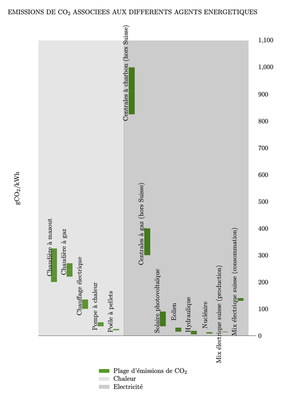How much CO2 does renewable energy emit?
All energy sources emit greenhouse gases. Renewable energies indirectly emit CO2, but much less than the combustion of fossil fuels (coal, petrol, diesel, natural gas). However, CO2 capture and sequestration technology could, in the long term, change this situation.
Every kWh of energy we consume contributes to global warming, because all energy sources release greenhouse gases (mainly CO2) into the air, either directly or indirectly. But some emit far more than others. Emissions caused by fossil fuels occur mainly during their combustion in engines, boilers, power plants, cement works, etc. Renewable energies also emit greenhouse gases, but mainly during the manufacture, transport, installation and dismantling of the necessary equipment (wind turbines, solar panels, etc.).
To compare the contribution of energy sources to global warming, their emissions are calculated in grams of CO2 per kWh of energy supplied ^[More specifically, in grams of “CO2 equivalent” (CO2eq), which makes it possible to take into account the other greenhouse gases also emitted (nitrogen oxides, methane, etc.). Fuel oil has a “carbon intensity” of 330 grams of CO2-equivalent per kWh (330 gCO2eq/kWh).]. Consider the example of oil heating; the extraction, transport, refining and combustion of the oil needed to provide one kWh of heat results in the emission of 330 grams of CO2-equivalent into the atmosphere. The oil is then said to have a “carbon intensity” of 330 grams of CO2-equivalent per kWh (330 g/CO2eq/kWh for short). This amount breaks down as follows: 24 g emitted during extraction of crude oil, 10 g during transport, 18 g during processing into a refinery, and 278 g during combustion in a boiler, representing 84% of the sector’s emissions. At 330 g, fuel oil has a very poor result compared to the alternatives available for heating: 270 g for natural gas, 130 g for direct electric heating, 40 g for the heat pump, and 20 g for wood [→ see figure below].
Equally large variations exist between the different electricity generation sectors. Coal-fired power plants are by far the worst in terms of greenhouse gas emissions: 1000 g per kWh! This is more than twice as much as electricity generated from natural gas: 400 g. Renewable energies have much better results: 40-90 g for photovoltaic solar (depending on the technology used), 15-25 g for wind (depending on the type of wind turbine), and less than 10 g for hydroelectricity. Nuclear power also has a very favourable CO2 result, of the order of 10 g per kWh for nuclear power in Switzerland, although there is a great deal of uncertainty surrounding this figure [→ Q17].
What about transportation fuels? Petrol and diesel emit almost the same amount of CO2-equivalent per kWh of energy supplied: 329 g for petrol, 317 g for diesel. Natural gas used as a fuel emits approximately 30% less: 223 g. Biofuels present a contrasting result, as their capacity to moderate global warming varies enormously from one product to another. Liquid biofuels, known as “1st generation” biofuels (from food plants such as corn, rapeseed, etc.), emit 70-90 g for bioethanol, and 140-200 g for biodiesel. Some of these biofuels therefore offer only limited potential for reducing greenhouse gas emissions, while being highly controversial in terms of their social and environmental impact. For these reasons, Switzerland consumes very little of them [→ Q56]. 2nd and 3rd generation biofuels, mainly from woody biomass (wood, grasses, etc.) or algae, are expected to generate significantly lower greenhouse gas emissions, in the order of 50-100 g. But these promising figures remain to be confirmed. Moreover, it will take at least until 2020 for these new biofuels to be commercialised on a large scale.
Biogas, which is used as a biofuel in gas-powered vehicles [→ Q33], has a very interesting carbon intensity, thanks to the fact that in Switzerland it is produced mainly from agricultural residues and sewage sludge: 40 g, which is 8 times less than petrol or diesel. As for electricity for electric cars and hydrogen for fuel cell vehicles, their respective CO2 balance will depend entirely on how they are produced. Derived from renewable resources, they can have a significant potential for decarbonising the transport sector [→ Q35] and [→ Q36].
In the end, renewable energies emit between 5 and 30 times less greenhouse gas than fossil-based energy sources [→ see figure below]. That said, we can envisage capturing and then sequestering the CO2 generated during the combustion of fossil fuels [→ Q91]. If this can be done reliably and at acceptable costs, some fossil fuels could become as low CO2 emitters as renewables.

References
- Swiss Centre for Life Cycle inventories (2019)
- Swiss Centre for Life Cycle inventories (2019). Ecoinvent. [Online]. Available at: www.ecoinvent.org. Retrieved from www.ecoinvent.org/database7